Ten things we’ve learned about the Higgs boson in the past ten years Understand article
The following was adapted from a CERN news article.
Meet the Higgs boson: what have physicists learned about this particle in the ten years since its discovery?
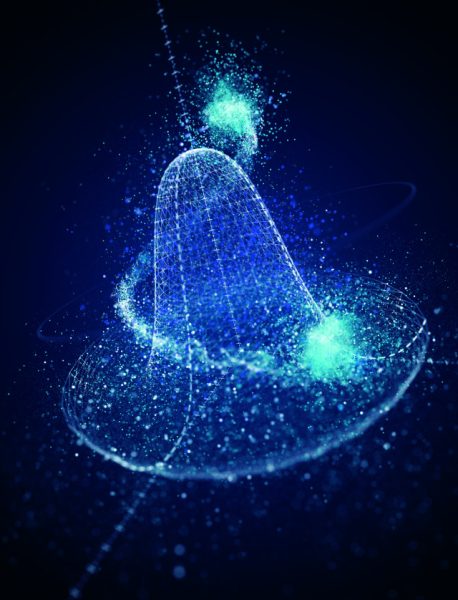
© CERN
The history of the Higgs boson
In the early 1960s, the Standard Model of Particle Physics (see Infobox 1) was developed to describe the fundamental interactions between elementary particles. However, it could not explain their observed mass. In 1964, a mechanism was proposed to describe how elementary particles could acquire mass through interaction with an invisible energy field that we now call the Brout–Englert–Higgs (BEH) field. The stronger the interaction of a particle with the field (coupling), the larger the particle’s mass. The theory also predicted a new particle that became known as the Higgs boson. In our current understanding, the BEH field is always present and fills the entire Universe. To create the Higgs boson, it is necessary to excite the BEH field.
Infobox 1: The Standard Model of Particle Physics
The Standard Model of Particle Physics (also called the Standard Model) is the most successful theory we have to date. The theory classifies all elementary particles (see figure 1) and describes the fundamental interactions between them, including three of the four known fundamental interactions (electromagnetic, weak and strong). The Standard Model has undergone numerous experimental tests and has even predicted the existence of particles before they were observed (e.g., the W and Z bosons, the gluon, the top and charm quarks). However, there are a number of open questions for the Standard Model because it does not address observations like dark matter, matter–antimatter asymmetry or why there are three families of quarks and leptons.
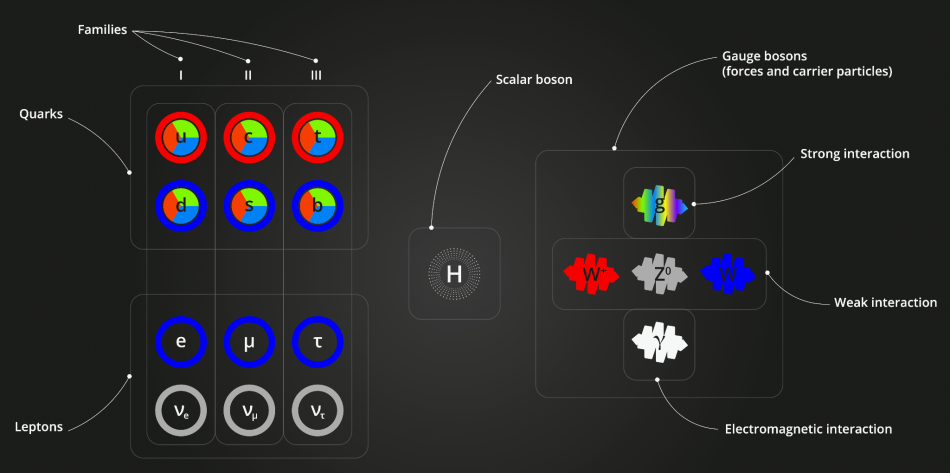
©CERN
To this end, the Large Hadron Collider (LHC) at CERN accelerates and collides highly energetic protons, providing enough collision energy to allow the creation of new particles. Two state-of-the-art detectors, the ATLAS[1] and the CMS[2] detectors, were constructed to detect the end products of such collisions and installed at opposite points along the 27 km LHC tunnel. By analysing an extremely high number of collision events, physicists were able to infer the existence of a Higgs boson in 2012.
This was the longest search for a predicted particle in the history of particle physics and required the largest physics experiments ever conducted, involving many thousands of scientists and engineers from around the world. After the discovery, the work on the theoretical prediction was awarded the Nobel Prize for Physics in 2013. So, what have we learned about this particle since its discovery?
1) A scalar particle exists in nature
Infobox 2: Fermions and (scalar) bosons
One essential property of elementary particles, along with their electric charge, colour charge and mass, is a property called “spin”. For example, electrons have a spin of 1/2, while photons have a spin of 1.
Elementary particles are classified as fermions if their spin is a half-integer (e.g., 1/2 or 3/2) or bosons if their spin is an integer (e.g. 0, 1, 2). In the Standard Model, fermions with a spin value of 1/2 make up the matter around us (figure 1, left), whereas bosons with a spin value of 1 are responsible for the interactions between matter elementary particles (figure 1, right). A special type of boson, the scalar boson, has a spin value of zero. To date, the particle discovered in 2012 is the only elementary scalar particle to be observed in nature.
During the early hours of 4 July 2012, the foyer outside the main CERN lecture hall looked more like the lead-up to a rock concert than the main building of the world’s leading particle physics lab (figure 2). Dozens of groggy-eyed students slowly rolled up their sleeping bags, stretching out after a long night on the hard floor. The excitement in the line was pulsating, even though the odds of making it into the auditorium were small. We had found it: the first scalar elementary particle! (See Infobox 2)
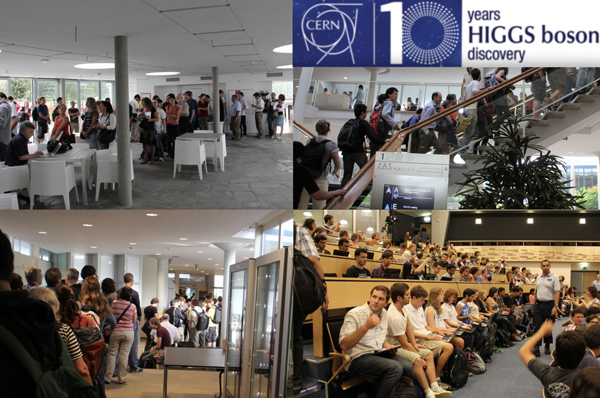
©CERN
2) It’s heavy and short-lived
Infobox 3: Particle transformations & experimental channels
Almost all known elementary particles are unstable at the present stage of our Universe and transform (also termed decay) into other particles. All transformation or decay processes follow conservation laws described by the Standard Model, including energy and momentum conservation.
Usually, there are different possible transformations or decay channels that a particle can undergo. For example, the Standard Model Higgs boson is predicted to decay to a pair of photons with a probability of about 2.3×10–03, meaning that for every thousand Higgs boson decays, about two will transform into two photons. The probability to observe a particular final state is often called the branching fraction, which may be predicted by the Standard Model.
The measured lifetime of the Higgs boson is, as predicted, extremely short (10–22 of a second). This is not enough time to leave any kind of direct signal in our detectors. Therefore, scientists can only infer the Higgs boson’s existence by carefully studying its decay products. By combining information from different components of the ATLAS and CMS detectors, scientists can identify the different particles, reconstruct their traces and measure their momenta. From this information, we can then infer properties of the initial particle, such as its mass.
For a precise calculation of the Higgs boson’s mass, a few experimental channels were selected. Examples of decay to two photons (two-photon decay) and to two muons and two electrons (a type of four-lepton decay), are shown in figure 3.

©CMS, ATLAS
The first measurements of the new scalar particle relied on two experimental channels (see Infobox 3): transformations to four electrically charged leptons (four electrons, four muons, or two electrons and two muons) and transformations to two photons. Figure 4 shows data used in the determination of the new particle’s mass through its decay to two photons, as observed by the CMS experiment. The upper part of the figure shows the number of events observed for each mass bin (black points), and the lower part shows the same quantity after subtracting the background contribution. By fitting the points with the expected lineshape (red line), physicists determined the mass of the new particle to be about 125 GeV/c2, which is interesting because it is much heavier than many physicists expected. In contrast to its large mass, the particle’s lifetime is short; it is gone in 10–22 s.
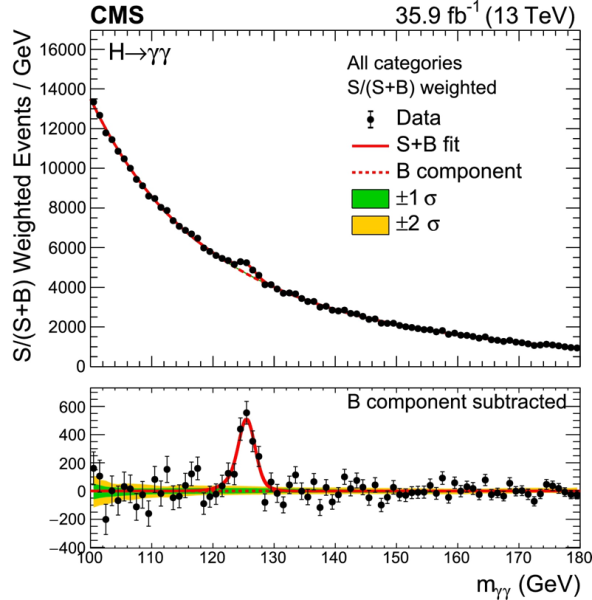
©CMS
3) It has no electric charge and no spin
Infobox 4: A Higgs boson or the Higgs boson?
The BEH mechanism is a theoretical concept that predicts a new particle that became known as the Standard Model Higgs boson. Although the mechanism can predict many properties and allow transformations of this particle (e.g., it should be electrically neutral and have no spin), it does not predict the particle’s mass. That said, for a given mass hypothesis, it is possible to calculate the particle’s branching fractions into the different predicted final states.
To date, all experimental measurements of the particle discovered in 2012, which has a mass close to 125 GeV/c2, are compatible with the predictions for the Standard Model Higgs boson, but the story is far from over and investigations will continue into the coming decades.
To distinguish between the Higgs boson predicted by the Standard Model and the new particle that was discovered in 2012 with a mass of about 125 GeV/c2, we refer to the latter as H(125).
During particle transformations, it is not just the total amount of energy and momentum that are conserved, but also the sum of all electric charges. Therefore, the discovery of the H(125) particle (see Infobox 4) via its decay to two photons immediately established that the new particle had no electric charge. Why? Let’s have a look at the two-photon decay of a Higgs boson:
H(125) → photon + photon
Since the electric charge of each photon is zero, the electric charge of the Higgs boson must also be zero.
Additionally, the spin of the new particle can be probed by examining the relative angles of the decay products. For example, we can look at the angle between the two photons in the two-photon decay. From this, scientists have concluded that H(125) is a scalar particle, i.e. it has a spin of 0.
4) It interacts with other bosons
How the Higgs boson interacts with other particles can be probed through both how it decays and how it is produced. With its discovery via decays to two photons and two Z bosons, it was concluded that the H(125) particle interacts with bosons. This was reaffirmed with measurements of decays to two W bosons.
5) It interacts with fermions
The Standard Model predicts that the strength of the coupling between the Higgs boson and other particles is proportional to their masses. That means that, when plotting the Higgs coupling strength as a function of each particle’s mass, the points should fall into a straight line.
Fermions are grouped into three families of increasing mass (figure 1). Therefore, this linear relationship can be tested by studying the Higgs couplings to the three fermion families. For the heaviest fermions, all couplings have been measured and the results match the prediction: the points fall into a straight line (figure 5).
The challenge now lies in reaching the second generation of fermions, which couple more weakly with the Higgs boson. Physicists have recently observed decays of H(125) to muons, and are focusing on decays to charm quarks.
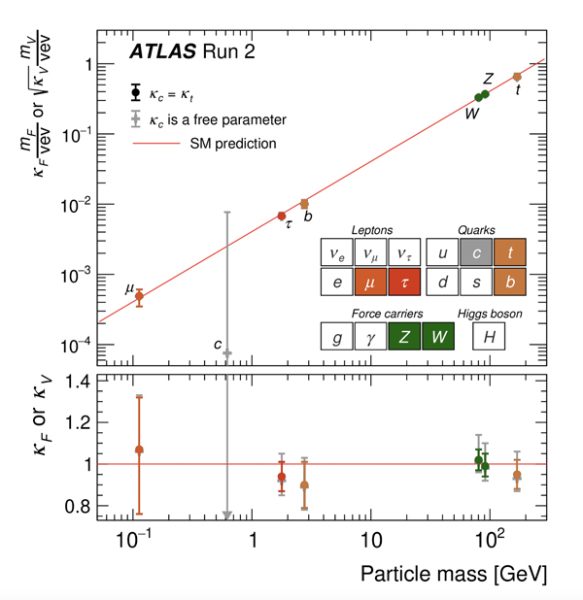
©ATLAS
6) It could be a portal for dark matter
From astronomical observations, we know that only a small fraction of all the matter in our Universe is visible matter made of elementary particles of the Standard Model (stars, planets, dust, etc.). However, most scientists believe that about 85% of all matter in the Universe is made up of invisible ‘dark matter’.
If dark matter consists of elementary particle(s), the Standard Model does not predict any of them. Given the connection between the Higgs boson and mass, let’s assume that the Higgs boson and dark matter particles interact in nature. Would it be possible to detect these interactions? Maybe. One possible signature is ‘invisible’ Higgs boson decays, that is, transformations of the Higgs boson to particles that don’t interact with our detectors. In the Standard Model, the only particles that interact so weakly that they escape detection are neutrinos. The only invisible Higgs boson decay predicted by the Standard Model is decay to four neutrinos, with a branching fraction of about 0.1%. If the H(125) particle and dark matter interact, this fraction of invisible decays of the Higgs boson would be significantly higher.
Currently, we can only say that any decays to invisible particles are less than 15% of all H(125) decays, so we have a long way to go until we will be able to challenge the Standard Model prediction.
7) It may touch the structure of the Universe
As mentioned, the measured mass of the H(125) particle was heavier than some theorists expected. This observation has very interesting implications for our Universe: a Higgs boson with a high mass suggests that our Universe may not be absolutely stable, but instead in a state between stable and metastable. In a stable Universe, the laws of physics and its fundamental constants are constant over time. In a metastable Universe, however, this is not the case.
To probe these scenarios, scientists study how the H(125) particle interacts with itself (self-interaction). One of the signatures that can be used to access this self-interaction is the production of Higgs boson pairs in proton–proton collisions. Because the probability for Higgs boson pair production is extremely small in the Standard Model, a large amount of data and intricate analyses are required.
Although the data collected so far are not enough, we estimate that by around 2040 we will have enough to probe the Standard Model prediction. Currently, we are developing new approaches to better understand and analyse the data.
8) It seems to be a lone child
The Standard Model of Particle Physics predicts only one elementary scalar particle. However, there is no fundamental reason for there to be just one and extensions to the Standard Model have been hypothesized that predict more than one Higgs boson. Therefore, scientists are searching for other Higgs bosons – lighter and heavier, neutral and electrically charged. So far these searches have been unsuccessful and the H(125) particle is presently the only scalar we know of.
9) It’s pushing us beyond the Standard Model
This Higgs boson is the newest player in the team of particles that we use to understand the nature of the Universe. There are many open questions, for example, about matter–antimatter asymmetry, dark matter, the number of fermion families and the unification of all forces. To address these questions, a detailed exploration of the properties of particles like the Z and W bosons, the beauty and top quarks, and now the H(125) particle, can probe energy regimes beyond those directly accessible at colliders and may point us in the direction of the next standard model.
10) It’s just the beginning
While we have established several properties and interactions of the H(125) particle, much remains to be learned. Is there really only one Higgs boson in nature? How do its properties differ from the Standard Model predictions? Might it interact with dark matter particles? Will we be able to use it to probe the stability of the Universe? Ten years ago, these questions were beyond our reach. In the coming years, the Higgs boson will be a powerful tool in our quest to understand not only the world of elementary particles but also the role they play in our Universe as a whole.
References
[1] The ATLAS experiment: https://atlas.cern/about
[2] The CMS experiment: https://cms.cern/detector
Resources
- Learn more about the topic with CERN’s The Higgs Discovery Explained
- Watch a short video on the Large Hadron Collider.
- Visit the LHC and learn about the science performed there with Physics Girl: Inside the world’s largest science experiment.
- Explore accelerator science with a virtual accelerator: Welsch CP (2021) Build your own virtual accelerator. Science in School 54.
- Build a cloud chamber with your students: Barradas-Solas F, Alameda-Meléndez P (2010) Bringing particle physics to life: build your own cloud chamber. Science in School 14: 36–40.
- Find out more about the use of proton beams for cancer therapy: Welsch CP (2021) Death Star or cancer tumour: proton torpedoes reach the target. Science in School
- Discover how a ‘disturbance in the force’ can help us measure particle beams without interfering with them: Welsch CP (2022) A disturbance in the Force gives insights into beam diagnostics. Science in School 58.
- Identify tracks of subatomic particles from their ‘signatures’ in bubble-chamber photos: Woithe J, Schmidt R, Naumann F (2019) Track inspection: how to spot subatomic particles. Science in School 46: 41–47.
- Learn about antimatter: Kwon D (2017) Ten things you might not know about antimatter. Science in School 42: 14–17.
- Build a particle accelerator in your classroom: Brown A, Merkert J, Wilson R (2014) Build your own particle accelerator. Science in School 30: 21–26.
- Spark your students’ interest in physics through Star Wars: Welsch CP (2021) The physics of Star Wars: introducing accelerator science. Science in School 54.
- Learn how students can participate in real science at CERN: Aretz S (2018) Students and science collide: CERN’s Beamline for Schools competition. Science in School 42.
- Take a look at the scale of the universe (small and big) with this interactive map.





